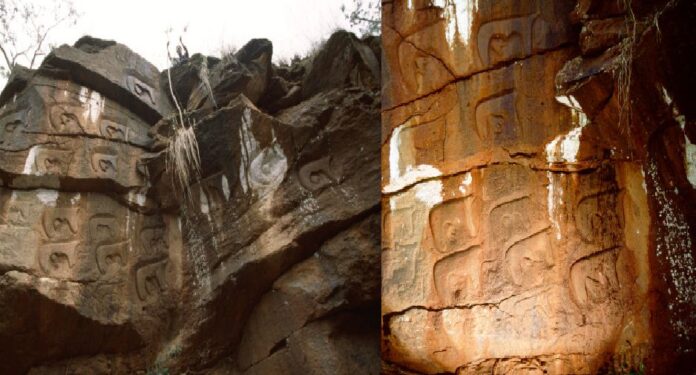The region of Shepe (otherwise called Chabbé, Šappe, or Mancheti) is situated in the Sidamo Zone of Oromia, around 250 km toward the south of Addis Ababa.
It’s a forest-mountainous, fertile area in Ethiopia, dedicated traditionally to planting coffee due to its ability to reproduce excellent yield.
The site is in a slender canyon cut by the Shepe River at 1300 m above ocean level, brimming with vegetation and consequently hard to identify.
Foundation of the rock art site of Shepe
A few remarkable engravings are portrayed in four boards along this crevasse, shaping one of the most noteworthy – whenever separated — rock art sites in the Horn of Africa.
The rock art site was founded in 1965 by Fitaorari Selechi Defabatchaw, the legislative leader of the Dilla area, and Francis Anfray published it two years after the establishment.
Since then, people have begun to perceive the significance of Shepe, and some different sites with comparable engravings have arisen in the encompassing region.
A group, generically called the Shepe-Galma, together with the Laga Oda-Sourré group in the Harar region, make up the entire regions of Ethiopian stone art.
A glimpse at the rock art of Shepe
The stone art of Shepe comprises solely of etchings of hump-less cows which follow extremely severe shows: little heads with long horns seen from a higher place, U-like midsections, profile bodies, and unmistakably portrayed udders.
Some cows, which the artists portray on the stone arts, have unidentified, three-sided objects draping from their left horn.
A total of 50 somewhat huge cows (40 to 70 cm long) are portrayed through the canyon dividers, arranged in groups and rows to represent herds.
A unique component of these engraving is, nonetheless, the method used to portray them. Rather than making carves of the cow’s outline, their region gives a bas-relief impact with no known equals in the area.
The ancient artists polished the outer layer of the cows to acquire a smooth appearance.
The chronology of the Shepe cow drawings
Determining the chronology of the Shepe cows is quite challenging. Still, from their style, one can relate them to Laga Oda paintings in the Harar area and different locales in Djibouti and Eritrea.
Researchers believe that the Shepe figures have the same attributes as the so-called Ethiopian-Arabian style, with a generic chronology from the third to the initial millennia BC.
Shepe etchings are generally naturalistic, and accordingly, ought to be among the most ancient portrayals of this style.
According to other interpretations, the Shepe and the nearby stone art sites are separate schools with an unclear chronology but will become evident in recent times.
Meaning of Shepe engravings
Regarding the meaning of Shepe cow rock engravings, no one can give the real sense except for speculations.
However, it appears very reasonable that peaceful networks made them major dairy cattle.
The cautious portrayal of the udders, the reiteration of this single theme, and the work paid to accomplish the bas-help impact suggest a vital significance of steers in the economy and society of the gathering that engraved them.
Some of the cows have what appear to be enhancements swinging from the horns (a component archived in other stone art locales as the Libyan Messak), additionally focusing toward that path.
Modern groups, for example, the Nuer in adjacent Sudan, have comparative customs of horn decorations.
All through the Omo stream district, people have reported various procedures of frivolity (ear cutting, horn forming, changes of the mound) have.
In every one of them, steers are a critical social imprint just as a monetary asset.
In actuality, no one can establish a direct connection between these modern examples and the communities that made the Shepe engravings.
However, the cow portrayals in the gorge are a record of the significance and thought given to steers, a creature that was undoubtedly part of these groups’ character.


